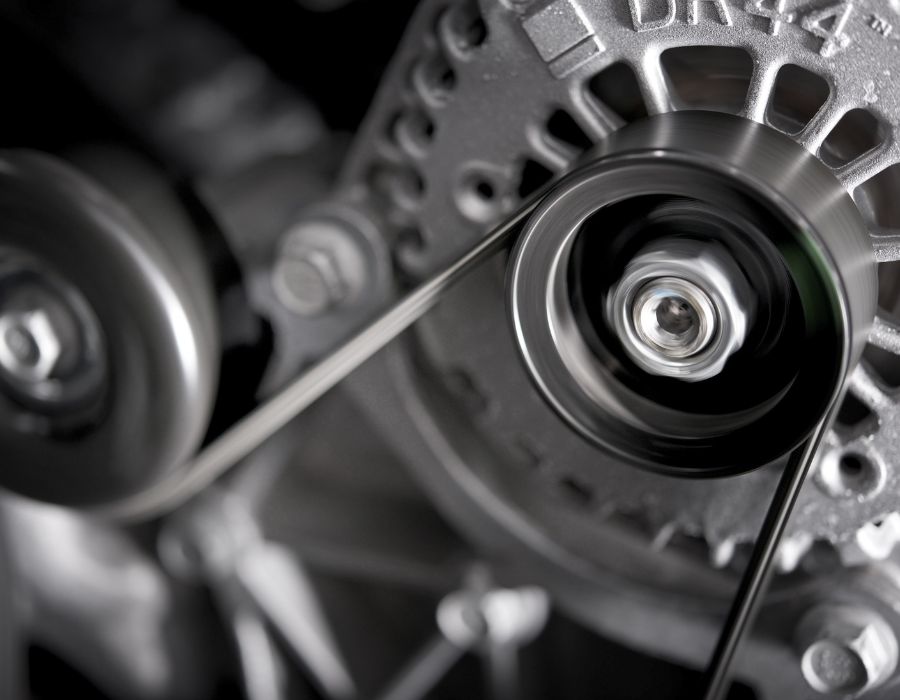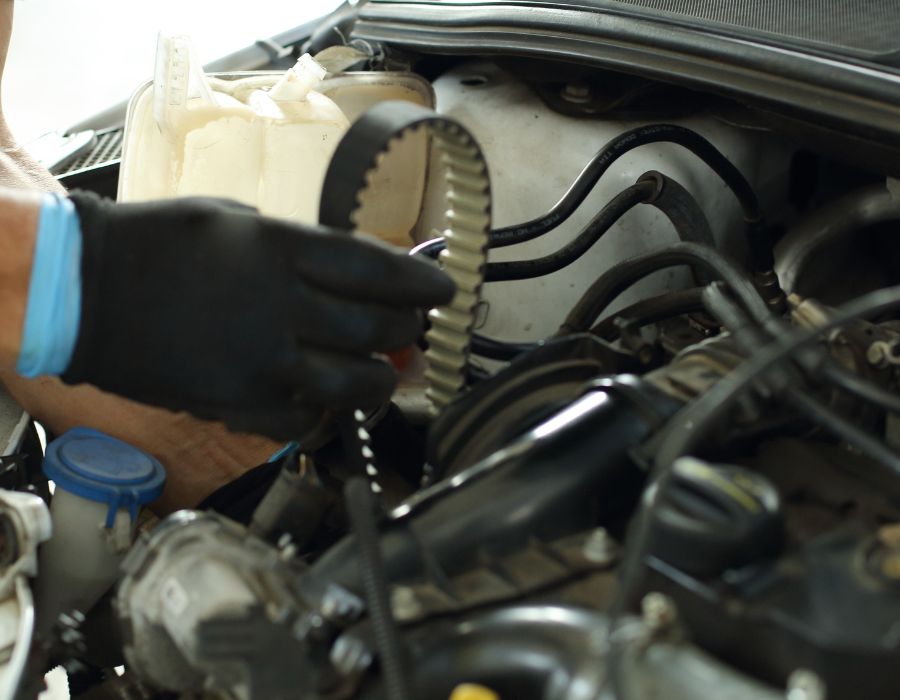Timing Belt Replacement in Lexington, KY
- CELEBRATING 46 YEARS
- Family Owned & Operated
- All Makes & Models
- CELEBRATING 46 YEARS
- Family Owned & Operated
- All Makes & Models
Contact Us
Timing Belt Replacement - Protect Your Engine's Perfect Timing
Robert thought the squealing noise from his engine was just a loose belt until his car suddenly died on the highway. His timing belt had snapped, and because he had an interference engine, bent valves turned a $500 timing belt job into a $3,000 engine rebuild. “I wish I’d known how important that timing belt was,” he said. We always tell customers: timing belt replacement is expensive, but timing belt failure is catastrophic.
Our Services
Contact Us
What Your Neighbors Are Saying About Us
They truly care about offering the right service and doing it at a very fair price. They were patient to explain everything in detail and had my car fixed same day. Their honesty and great service will keep me coming back for all of my car needs. A solid repair shop that will be my first choice going forward.
Could not be happier with the recent service I received at Powers Transmissions! David and his team are very knowledgeable and pleasant to work with. It’s nice to have the peace of mind knowing everything is done correctly. Very happy with the experience and highly recommend!
What stood out to me was their willingness to listen to my concerns over the phone and provide an accurate estimate for the repair timeline. Unlike some places, they didn't try to deceive me just to get me in the door. You can genuinely sense their passion for their work and helping customers.
Wow, excellent job. My HUMMER H2 runs so good. Now the Transmission can pull a barn down I have known Mr. powers for years. He is a stand up guy if he says something you can take it to the bank. I'm very happy.
Powers Transmissions took over and had my car done in less than a week. They worked with my warranty company and kept me updated on everything that was happening. Completely professional and competent unlike the first place I went! Thank you for all your help!

What Your Timing Belt Does
Your timing belt is one of the most important components in your engine. It synchronizes the rotation of your crankshaft and camshaft, ensuring that your engine’s valves open and close at exactly the right time in relation to piston movement.
This timing is critical. If the timing is off by even a few degrees, your engine won’t run properly. If your timing belt breaks while driving, your engine stops immediately, and in interference engines, the pistons can hit the valves, causing thousands of dollars in damage.
Interference vs Non-Interference Engines
- Interference Engines: The pistons and valves occupy the same space at different times. If the timing belt breaks, pistons hit valves, causing severe engine damage.
- Non-Interference Engines: There’s clearance between pistons and valves even when the timing belt breaks. You’ll need a new belt, but usually no internal engine damage occurs.
Most modern engines are interference designs for better efficiency and performance. This makes timing belt maintenance even more important than it used to be.
Signs Your Timing Belt Needs Replacement
- Mileage: Most timing belts need replacement every 60,000 to 100,000 miles. Check your owner’s manual for specific intervals.
- Age: Even if you haven’t reached the mileage limit, timing belts should be replaced every 5-7 years. Rubber deteriorates over time regardless of mileage.
- Squealing Noise: A high-pitched squealing from the front of the engine can indicate a worn timing belt or tensioner.
- Rattling Sounds: Loose timing belt tensioners can cause rattling noises, especially when starting the engine.
- Metal Shavings: If you find metal particles in your oil, your timing belt might be wearing and shedding debris.
- Engine Won’t Start: If your engine cranks but won’t start, and you’re due for timing belt replacement, the belt might have broken.
- Rough Idle: A stretched timing belt can cause timing to drift, resulting in rough idle and poor performance.


Our Timing Belt Replacement Process
Timing belt replacement is complex work that requires precision and experience:
- Complete Inspection: We inspect the entire timing system, including the belt, tensioners, idler pulleys, and water pump.
- Component Replacement: We typically replace the timing belt, tensioner, and idler pulleys as a complete system. The water pump is often replaced at the same time since it’s driven by the timing belt.
- Timing Verification: After installation, we carefully set the timing according to manufacturer specifications using specialized tools.
- Quality Parts: We use OEM or equivalent quality timing belts and components. Cheap timing belts are a false economy when engine damage is the penalty for failure.
- Road Testing: We test drive your vehicle to verify proper engine operation and timing.
Why Replace More Than Just the Belt
- Tensioners and Pulleys: These components wear at the same rate as the timing belt. Replacing only the belt while leaving worn tensioners is asking for problems.
- Water Pump: Many water pumps are driven by the timing belt. Since accessing the water pump requires removing the timing belt anyway, it makes sense to replace both.
- Seals and Gaskets: Timing belt replacement involves removing covers and components. We replace seals and gaskets that might leak later.

Timing Belt vs Timing Chain
- Timing Belts: Quieter operation, lighter weight, but require regular replacement. Found on many four-cylinder and some V6 engines.
- Timing Chains: Last longer (often the life of the engine) but noisier and heavier. Used on most V8 engines and some modern four-cylinders.
- Maintenance: Chains typically only need replacement if they stretch excessively or if tensioners fail. Belts require preventive replacement.
Cost Considerations
Timing belt replacement typically costs $500-1,200 depending on your vehicle. This might seem expensive, but compare it to the cost of engine replacement if the belt breaks:
Bent Valves: $1,500-2,500 repair Damaged Pistons: $2,000-4,000 repair
Complete Engine: $3,000-6,000 replacement
When you look at it this way, timing belt replacement is cheap insurance against catastrophic engine failure.
Seasonal Timing Considerations
- Before Summer Travel: If you’re planning a long summer road trip and your timing belt is approaching replacement time, do it before you leave. Breaking down far from home is expensive and inconvenient.
- Winter Reliability: Cold weather can accelerate timing belt deterioration. If your belt is borderline, winter is not the time to gamble on its reliability.
- Temperature Extremes: Both hot and cold weather stress timing belts. If you live in an area with extreme temperatures, consider replacing your belt at the lower end of the mileage range.
Timing Belt Maintenance Tips
- Follow the Schedule: Don’t exceed manufacturer replacement intervals. The money you save by waiting isn’t worth the risk.
- Quality Matters: Use OEM or high-quality aftermarket timing belts. Cheap belts are more likely to fail prematurely.
- Complete Replacement: Replace tensioners and idler pulleys with the belt. These components work together and should be serviced together.
- Professional Installation: Timing belt replacement requires specialized tools and knowledge. This isn’t a DIY job for most people.

Warning Signs of Timing Problems
- Engine Misfires: Incorrect timing can cause misfires, especially under load.
- Poor Performance: Loss of power or poor acceleration can indicate timing problems.
- Increased Emissions: Timing problems often cause vehicles to fail emissions tests.
- Unusual Noises: Rattling, squealing, or grinding from the timing cover area needs immediate attention.
Emergency Timing Belt Failure
If your timing belt breaks while driving:
- Pull over safely immediately
- Don’t attempt to restart the engine
- Have your vehicle towed to our shop
- Don’t panic – even interference engines can sometimes avoid damage if you stop quickly
Attempting to restart an engine with a broken timing belt can turn a belt replacement into an engine rebuild.


Preventive Replacement Benefits
Why Choose Our Timing Belt Service
We’ve been performing timing belt replacements for over 15 years. Our ASE-certified technicians have the specialized tools and experience needed to do this complex job correctly.
We use only quality timing belts and components, and we stand behind our work with comprehensive warranties. When we replace your timing belt, you can drive with confidence knowing your engine is protected.
Schedule Your Timing Belt Service
Don’t gamble with timing belt failure. If you’re approaching your replacement interval or experiencing any warning signs, give us a call. We provide detailed estimates and explain exactly what your vehicle needs. Timing belt replacement is expensive, but engine replacement is much more expensive. Protect your investment with proper timing belt maintenance.

Areas We Serve
- Winchester Lexington
- Lane Allen Lexington
